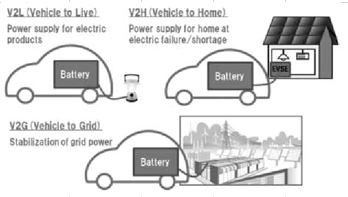Vehicle-to-everything (V2X) is a technology that enables bidirectional charging possibility between vehicle battery to many different use cases such as homes, buildings, services, factories, power grids, or even another vehicle. V2X is often considered as a solution for emergency power supply in the event of a power outage or, especially in case of vehicle-to-grid (V2G) for inevitable grid problems when the peak energy demand is higher than the supply capacity of the grid.

V2L (Vehicle to Live), V2H (Vehicle to Home) and V2G (Vehicle to Grid). Source: https://global-sei.com/technology/tr/bn79/pdf/79-08.pdf
V2X not only helps the consumers to save their electricity bill but also supports mitigating climate change and scaling up renewable energy by increasing the backup capacity and balancing between energy demand and consumption. Fleet electric vehicles with centralised charging depots can potentially benefit the most from V2X technology. To give an example, the vehicles can be charged during midday hours when solar output is at the highest, or during night when the price of electricity is at the lowest, and then return the power back to grid during evening when electricity consumption peak. V2X technology is currently being used mainly on passenger vehicles but also being investigated for its potential in B2B applications in buses and trucks.
V2X requires vehicle with discharge functionality, bidirectional charger, communications link between the charger and the vehicle using a V2G-compliant communications protocols ISO 15118 and OCPP 2.0.1, and smart charging control system that supports V2G charger.
Currently, V2X technology has been tested in few pilots arround the world. One of the reasons that this technolgy has not rolled-out yet is that to this date only few BEV support bi-directional charging.
Comments ()